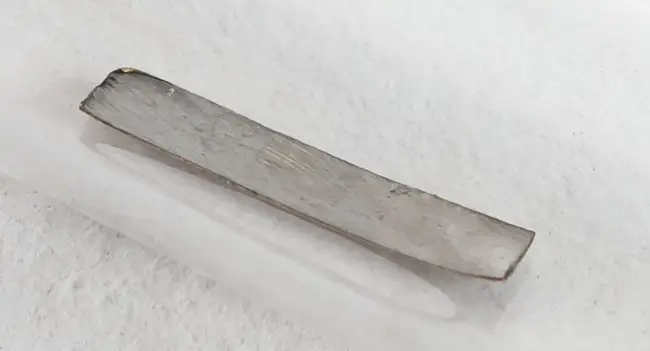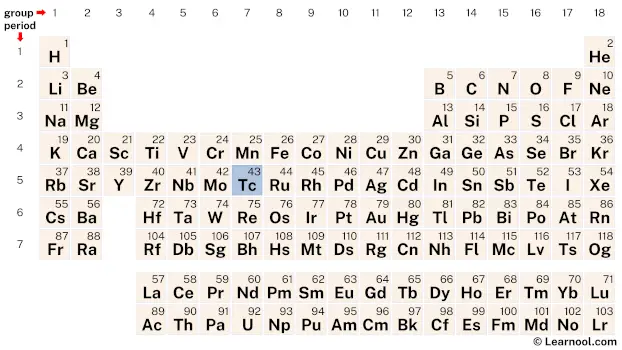
Technetium (Tc) is a chemical element of the periodic table, located in the group 7 and the period 5, and has the atomic number 43. It is a rare, silvery-grey transition metal, whose name comes from the Greek word “technetos”, which means artificial. It is counted as one of the radioactive elements.
On periodic table
| group | ⇨ | 1 | 2 | 3 | 4 | 5 | 6 | 7 | 8 | 9 | 10 | 11 | 12 | 13 | 14 | 15 | 16 | 17 | 18 |
| period | ⇩ | ||||||||||||||||||
| 1 | 1 H  Hydrogen |
2 He  Helium |
|||||||||||||||||
| 2 | 3 Li  Lithium |
4 Be  Beryllium |
5 B  Boron |
6 C  Carbon |
7 N  Nitrogen |
8 O  Oxygen |
9 F  Fluorine |
10 Ne  Neon |
|||||||||||
| 3 | 11 Na  Sodium |
12 Mg  Magnesium |
13 Al  Aluminium |
14 Si Silicon |
15 P  Phosphorus |
16 S  Sulfur |
17 Cl  Chlorine |
18 Ar  Argon |
|||||||||||
| 4 | 19 K  Potassium |
20 Ca  Calcium |
21 Sc  Scandium |
22 Ti  Titanium |
23 V  Vanadium |
24 Cr  Chromium |
25 Mn  Manganese |
26 Fe  Iron |
27 Co  Cobalt |
28 Ni  Nickel |
29 Cu  Copper |
30 Zn  Zinc |
31 Ga  Gallium |
32 Ge  Germanium |
33 As  Arsenic |
34 Se  Selenium |
35 Br  Bromine |
36 Kr  Krypton |
|
| 5 | 37 Rb  Rubidium |
38 Sr  Strontium |
39 Y  Yttrium |
40 Zr  Zirconium |
41 Nb  Niobium |
42 Mo  Molybdenum |
43 Tc Technetium |
44 Ru  Ruthenium |
45 Rh  Rhodium |
46 Pd  Palladium |
47 Ag  Silver |
48 Cd  Cadmium |
49 In  Indium |
50 Sn  Tin |
51 Sb  Antimony |
52 Te  Tellurium |
53 I  Iodine |
54 Xe  Xenon |
|
| 6 | 55 Cs  Caesium |
56 Ba  Barium |
72 Hf  Hafnium |
73 Ta  Tantalum |
74 W  Tungsten |
75 Re  Rhenium |
76 Os  Osmium |
77 Ir  Iridium |
78 Pt  Platinum |
79 Au  Gold |
80 Hg  Mercury |
81 Tl  Thallium |
82 Pb  Lead |
83 Bi  Bismuth |
84 Po  Polonium |
85 At  Astatine |
86 Rn  Radon |
||
| 7 | 87 Fr  Francium |
88 Ra  Radium |
104 Rf  Rutherfordium |
105 Db  Dubnium |
106 Sg  Seaborgium |
107 Bh  Bohrium |
108 Hs  Hassium |
109 Mt  Meitnerium |
110 Ds  Darmstadtium |
111 Rg  Roentgenium |
112 Cn  Copernicium |
113 Nh  Nihonium |
114 Fl  Flerovium |
115 Mc  Moscovium |
116 Lv  Livermorium |
117 Ts  Tennessine |
118 Og  Oganesson |
||
| 57 La  Lanthanum |
58 Ce  Cerium |
59 Pr  Praseodymium |
60 Nd  Neodymium |
61 Pm  Promethium |
62 Sm  Samarium |
63 Eu  Europium |
64 Gd  Gadolinium |
65 Tb  Terbium |
66 Dy  Dysprosium |
67 Ho  Holmium |
68 Er  Erbium |
69 Tm  Thulium |
70 Yb  Ytterbium |
71 Lu  Lutetium |
|||||
| 89 Ac  Actinium |
90 Th  Thorium |
91 Pa  Protactinium |
92 U  Uranium |
93 Np  Neptunium |
94 Pu  Plutonium |
95 Am  Americium |
96 Cm  Curium |
97 Bk  Berkelium |
98 Cf  Californium |
99 Es  Einsteinium |
100 Fm  Fermium |
101 Md  Mendelevium |
102 No  Nobelium |
103 Lr  Lawrencium |
|||||
| – d block |
Technetium is a d-block element, situated in the seventh column and the fifth row of the periodic table. Its atomic number is 43 and its symbol is Tc.
Element information
 |
|
 |
|
| Origin of name | Greek word “technetos” (which means artificial) |
| Symbol | Tc |
| Atomic number (Z) | 43 |
| Atomic mass | (98) |
| Block | d-block |
| Group | 7 |
| Period | 5 |
| Classification | Transition metal |
| Atomic radius | 136 pm |
| Covalent radius | 147±7 pm |
| Melting point | 2157 ℃, 3915 ℉, 2430 K |
| Boiling point | 4265 ℃, 7709 ℉, 4538 K |
| Electron configuration | [Kr] 4d5 5s2 |
| Electrons per shell | 2, 8, 18, 13, 2 |
| Crystal structure | Hexagonal close-packed (hcp) |
| Phase at r.t | Solid |
| Density near r.t | 11 g/cm3 |
| Natural occurrence | From decay |
| Oxidation state | +4, +7 |
| Electronegativity (Pauling scale) | 1.9 |
| Protons Neutrons Electrons |
43 55 43 |
| CAS number | 7440-26-8 |
| Discovered by | Emilio Segrè and Carlo Perrier in 1937 |
History
Technetium was the first element to be artificially produced. Its discovery is credited to Italian physicist Emilio Segrè and American chemist Carlo Perrier, who in 1937 bombarded molybdenum with deuterons in a cyclotron to produce technetium-97.
However, the element was actually predicted to exist in 1925 by Russian chemist Dmitry Mendeleyev, who created the periodic table of elements. He noticed a gap in the table between manganese and rhenium and predicted that an element with atomic number 43 would fill it.
After its discovery, technetium was initially called “masurium” by its discoverers, but this name was later changed to “technetium,” which comes from the Greek word “technetos,” meaning “artificial.” Technetium has since become an important element in nuclear medicine, as it can be used in a variety of medical imaging techniques.
Occurrence and production
Technetium is a relatively rare element in the Earth’s crust, with an estimated abundance of just 0.00005 parts per million. It is primarily produced artificially, with no stable isotopes found in nature. Technetium is created through the process of nuclear fission, and can be produced by bombarding molybdenum or ruthenium targets with neutrons in a nuclear reactor.
Once technetium is produced, it can be separated from the target material using a variety of methods, such as ion exchange, solvent extraction, or precipitation. The production of technetium is strictly controlled due to its radioactive properties and potential health hazards. As a result, it is mainly used in research and medical applications, such as in diagnostic imaging tests.
Properties
Technetium is a silvery-gray, radioactive metal that has a high melting point of 2157 ℃ and a boiling point of 4262 ℃.
It is a transition metal and can form a variety of oxidation states, but its most common oxidation states are +4 and +7.
Technetium has a high density of 11 g/cm3, making it denser than most other transition metals.
It is a good conductor of electricity and heat.
Technetium is paramagnetic, meaning that it is weakly attracted to a magnetic field.
The metal is highly reactive and can readily form compounds with other elements, especially with oxygen and halogens.
Technetium has no stable isotopes, and all of its isotopes are radioactive. The most stable isotope of technetium is technetium-98, which has a half-life of 4.2 million years.
Applications
Nuclear medicine
Technetium has a variety of uses, especially in the field of nuclear medicine. Due to its radioactive properties, it is used in medical imaging to diagnose a variety of medical conditions.
Technetium-99m is the most commonly used radioisotope in nuclear medicine, as it can be easily produced in a generator and has a short half-life of about 6 hours. It is used in diagnostic imaging procedures such as single-photon emission computed tomography (SPECT) and gamma camera imaging.
Petroleum industry
Technetium is also used in the petroleum industry as a catalyst in the production of high-octane gasoline. It is added to molybdenum-based catalysts to improve their performance in the desulfurization process.
Additionally, technetium-99m is used in the production of certain radiopharmaceuticals that are used to detect leaks in pipelines and storage tanks.
Nuclear engineering
In the field of nuclear engineering, technetium is used as a tracer to monitor the flow of fluids and gases through pipelines and other industrial systems.
It is also used as a gamma-ray source in industrial radiography, allowing for non-destructive testing of materials and components.
Alloys
Outside of its nuclear applications, technetium has been used in some specialized alloys, such as in the production of certain types of steel.
However, its high radioactivity and rarity make it an expensive and challenging material to work with, limiting its commercial use in non-nuclear applications.
Interesting facts
Technetium is the lightest element that does not occur naturally on Earth.
It was the first artificially produced element, created in a cyclotron in 1937.
Technetium has no stable isotopes, meaning that all forms of technetium are radioactive.
Most isotopes of technetium have much shorter half-lives ranging from fractions of a second to a few hours.
Technetium’s short half-life allows for safe medical imaging procedures, as it quickly decays and eliminates from the patient’s body.
Technetium-99m is a commonly used radioactive isotope in medical imaging, with over 40 million procedures using it annually worldwide. It has a short half-life of approximately 6 hours, meaning it can be used for diagnostic purposes without causing long-term radiation exposure.
Technetium has potential uses in nuclear batteries due to its radioactivity, but this technology is still in the experimental stage.
The name “technetium” comes from the Greek word “technetos,” meaning “artificial,” reflecting its man-made origin.
Technetium is often used as a tracer element in scientific research to study chemical reactions and biological processes.
Related
More elements
External links
- https://en.wikipedia.org/wiki/Technetium
- https://www.rsc.org/periodic-table/element/43/technetium
- https://www.britannica.com/science/technetium
- https://education.jlab.org/itselemental/ele043.html
- https://pubchem.ncbi.nlm.nih.gov/element/Technetium
- https://www.chemicool.com/elements/technetium.html
- https://www.livescience.com/34774-technetium.html
- http://pubs.acs.org/cen/80th/technetium.html
Deep
Learnool.com was founded by Deep Rana, who is a mechanical engineer by profession and a blogger by passion. He has a good conceptual knowledge on different educational topics and he provides the same on this website. He loves to learn something new everyday and believes that the best utilization of free time is developing a new skill.
